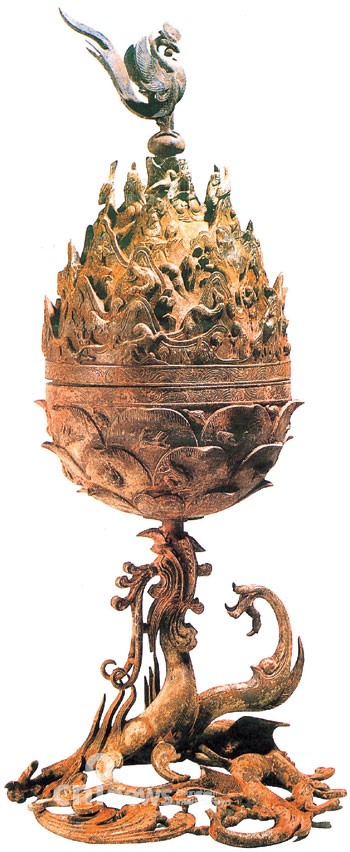About Chungnam
News
Baekje Gilt-Bronze Incense Burner
A Masterpiece, in Which the Baekje People Delicately Chased their Ideal World
2009.08.14(금) | CNnews (![]() chungnamdo@korea.kr)
chungnamdo@korea.kr)
 |
||
| ▲ Baekje Gilt-Bronze Incense Burner Height 62.5cm, Weight 12.8kg, National Treasure No. 287. In Buyeo National Museum | ||
One of the crowning excavation achievements in the past century, the Baekje Gilt-Bronze Incense Burner, gave a critical turning point to the studies in the Baekje Dynasty history. The Burner embraces the mind of the Baekje people who delicately chased their ideal world with exquisite techniques and high appreciative eyes. The Incense Burner of this kind has not been found anywhere in the world since then. It is no wonder that it can be really called a masterpiece.
The Baekje Gilt-Bronze Incense Burner(National Treasure No. 287) was found in 1993 during the excavation of a temple site of Baekje Dynasty (18 BC to AD 660) near the ancient tombs at Neungsan-ri located at 4 km eastern outskirt from Buyeo. The conditions identified during the excavation tell us about the very urgent circumstances of the time the Sabi Capital Castle fell. The emergence of the Incense Burner after the lapse of more than 1330 years provided historians with the largest opportunity to go on studying the Baekje Dynasty history. Until then, knowledge had been confined within a range of very deficient data and prejudices since the excavation of King Muryeong’s tomb in Gongju.
Weighing 12.8kg and 62.5cm tall, the Incense Burner was manufactured with bronze molded and then gold electroplated. A Chinese phoenix stands on the lid and a dragon supports the burner. Each of those was independently manufactured and then assembled.
The Chinese phoenix takes a leaping pose, spreading its wings fully. It is the typical divine bird of the Eastern Asia symbolizing Positive Energy. It is also called a Divine Bird, a Fortunate Bird, or a Heavenly Bird. It is the imaginary bird that will reemerge in the world when a nation enjoys the blessings of peace under the good and intelligent reign of a king. It is called a Messiah animal that makes people’s wishes come ture. Since five mandarin ducks like the shapes of wild geese were placed on each of the peaks around the Chinese phoenix and five supernatural beings performing the five traditional musical instruments were placed on each of the inner parts of the five peaks. It depicts a stage of the ancient tale regarding reemergence of Chinese phoenix as it is.
The lid below the Chinese phoenix has 25 peaks. Five peaks were multiplied by five stages, and the forty-nine peaks connecting the intervals made huge mountains, in which 37 divine animals , five musicians, and 17 people including supernatural beings, gurus, children, knights, and soldiers riding on horses like kings were depicted. Particularly, the shape of a supernatural being performing his ablutions under a fall is relevant to the historical record that the Baekje Dynasty worshiped the Heavens and the Five Emperors. An old guru was placed on the bottom of the lid surrounded with three stage relief plate and five stage plate. That has a two stage intaglio plate, and two supernatural beings and 25 divine animals placed in the front, the center, and at intervals with the lotus flower, most of which are related to maritime animals such as fish with wings, otters, and a guru riding on a crane, and the like.
The dragon on the bottom support that is a divine animal representing typically Negative Energy, whose horn shape and representing method indicates a typical Korean dragon with four legs, a tale, and five claws. And the dragon reaching out one of its legs in the empty air while stretching its toes represents its dynamicity fully. The fact that a number of flowers, waves, and lotus folower patterns are harmonized on the dragon body adds up to a mystery. Moreover such an ornament is closely related to the wall paintings of Goguryeo ancient tombs.
The basic ornament patterns of the Incense Burner conform to the various cultural heritages excavated from King Muryeong’s tomb in Gongju and followed the traditional shape of Chinese incense burner as shown in wall paintings of Goguryeo ancient tombs and ancient historical records. Buddhist and Taoism worlds resting on the basis of supernatural thoughts of the Baekje people were depicted by the high artistic viewpoint and methods in the Incense Burner, which could be the essence of Korean spiritual culture and a typical masterpiece in the ancient Northeastern Asia.




